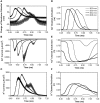Conduction block in myelinated axons induced by high-frequency (kHz) non-symmetric biphasic stimulation
- PMID: 26217217
- PMCID: PMC4491630
- DOI: 10.3389/fncom.2015.00086
Conduction block in myelinated axons induced by high-frequency (kHz) non-symmetric biphasic stimulation
Abstract
This study used the Frankenhaeuser-Huxley axonal model to analyze the effects of non-symmetric waveforms on conduction block of myelinated axons induced by high-frequency (10-300 kHz) biphasic electrical stimulation. The results predict a monotonic relationship between block threshold and stimulation frequency for symmetric waveform and a non-monotonic relationship for non-symmetric waveforms. The symmetric waveform causes conduction block by constantly activating both sodium and potassium channels at frequencies of 20-300 kHz, while the non-symmetric waveforms share the same blocking mechanism from 20 kHz up to the peak threshold frequency. At the frequencies above the peak threshold frequency the non-symmetric waveforms block axonal conduction by either hyperpolarizing the membrane (if the positive pulse is longer) or depolarizing the membrane (if the negative pulse is longer). This simulation study further increases our understanding of conduction block in myelinated axons induced by high-frequency biphasic electrical stimulation, and can guide future animal experiments as well as optimize stimulation parameters that might be used for electrically induced nerve block in clinical applications.
Keywords: block; high-frequency; model; nerve; simulation.
Figures







Similar articles
-
Effect of non-symmetric waveform on conduction block induced by high-frequency (kHz) biphasic stimulation in unmyelinated axon.J Comput Neurosci. 2014 Oct;37(2):377-86. doi: 10.1007/s10827-014-0510-z. Epub 2014 Jun 14. J Comput Neurosci. 2014. PMID: 24928360 Free PMC article.
-
Simulation analysis of nerve block by high frequency biphasic electrical current based on frankenhaeuser-huxley model.Conf Proc IEEE Eng Med Biol Soc. 2005;2005:4247-50. doi: 10.1109/IEMBS.2005.1615402. Conf Proc IEEE Eng Med Biol Soc. 2005. PMID: 17281172
-
Mechanism of nerve conduction block induced by high-frequency biphasic electrical currents.IEEE Trans Biomed Eng. 2006 Dec;53(12 Pt 1):2445-54. doi: 10.1109/TBME.2006.884640. IEEE Trans Biomed Eng. 2006. PMID: 17153201 Free PMC article.
-
Peripheral Nerve Conduction Block by High-Frequency Alternating Currents: A Systematic Review.IEEE Trans Neural Syst Rehabil Eng. 2018 Jun;26(6):1131-1140. doi: 10.1109/TNSRE.2018.2833141. IEEE Trans Neural Syst Rehabil Eng. 2018. PMID: 29877837
-
Molecular dissection of the myelinated axon.Ann Neurol. 1993 Feb;33(2):121-36. doi: 10.1002/ana.410330202. Ann Neurol. 1993. PMID: 7679565 Review.
Cited by
-
Modeling the response of small myelinated axons in a compound nerve to kilohertz frequency signals.J Neural Eng. 2017 Aug;14(4):046022. doi: 10.1088/1741-2552/aa6a5f. J Neural Eng. 2017. PMID: 28361793 Free PMC article.
-
HFAC Dose Repetition and Accumulation Leads to Progressively Longer Block Carryover Effect in Rat Sciatic Nerve.Front Neurosci. 2022 May 27;16:852166. doi: 10.3389/fnins.2022.852166. eCollection 2022. Front Neurosci. 2022. PMID: 35712453 Free PMC article.
-
Membrane depolarization mediates both the inhibition of neural activity and cell-type-differences in response to high-frequency stimulation.Commun Biol. 2024 Jun 18;7(1):734. doi: 10.1038/s42003-024-06359-3. Commun Biol. 2024. PMID: 38890481 Free PMC article.
-
Effect of percutaneous electrical stimulation with high-frequency alternating currents at 30 kHz on the sensory-motor system.Front Neurosci. 2023 Feb 9;17:1048986. doi: 10.3389/fnins.2023.1048986. eCollection 2023. Front Neurosci. 2023. PMID: 36845426 Free PMC article.
-
Kilohertz alternating current neuromodulation of the pudendal nerves: effects on the anal canal and anal sphincter in rats.J Appl Biomed. 2022 Jun;20(2):56-69. doi: 10.32725/jab.2022.009. Epub 2022 Jun 21. J Appl Biomed. 2022. PMID: 35727123
References
-
- Boyce W. E., Diprima R. C. (1997). Elementary Differential Equations and Boundary Value Problems, 6th Edn. Hoboken, NJ: John Wiley & Sons, Inc.
Grants and funding
LinkOut - more resources
Full Text Sources
Other Literature Sources

